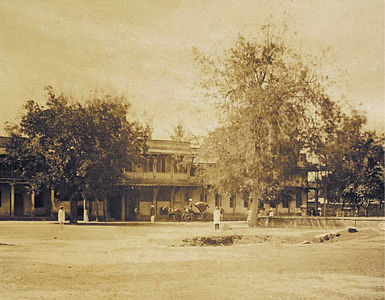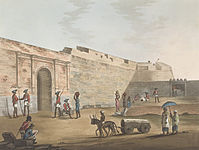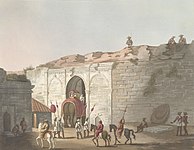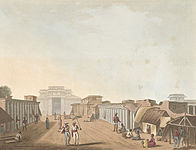Bangalore Fort
| Bangalore Fort | |
|---|---|
| Part of Kempegowda I | |
| Materials | built in 1751 CE with granite stones south of 2 centuries old mud fort |
Bangalore Fort began in 1537 as a mud fort.
History
The confirmed history of the Bangalore Fort is traced to 1537, when Kempe Gowda I (pictured), a chieftain of the Vijayanagara Empire, widely held as the founder of modern Bangalore, built a mud fort and established the area around it as Bengaluru Pete, his capital.[3][4]

Kempe Gowda I, who showed remarkable qualities of leadership from childhood, had a grand vision to build a new city which was further fueled by his visits to
Kempe Gowda moved from his ancestral land of
Thereafter, he constructed a
In 1637–38, the Bangalore Fort under Kempe Gowda's rule was very prosperous. Rustam i Zaman, the commander under the Bijapur Sultanate who was on a war campaign, and after he had captured the
This mud fort was enlarged during Chikkadeva Raya
In March 1791 the army of the
- Siege of Bangalore, 1791
-
The Death of Colonel Moorhouse at the Storming of the Pettah Gate of Bangalore
-
Siege of Bangalore (1791) British Plaque, Bangalore Fort
-
Storming and taking Bangalore, by the Marquis Cornwallis[9]
Fort structure
The Bangalore fort, ca. 1791, was described as follows:[10]
Bangalore, like Madras, had a fort, with a pettah, or fortified town, outside it. This lay-out was a feature of almost all the cities or settlements in India, the fort providing a place of refuge for most of the inhabitants if the pettah was in danger of capture. The fort at Bangalore had a perimeter of about one mile; it was of solid masonry, surrounded by a wide ditch which was commanded from 26 towers placed at intervals along the ramparts. To its north lay the pettah, several miles in circumference and protected by an indifferent rampart, a deep belt of thorn and cactus, and a small ditch. Altogether Bangalore was not a place which invited attack.
— Sandes, Lt Col E.W.C. (1933) The Military Engineer in India, Vol 1
-
Old Fort at Bangalore (MacLeod, p. 144, 1871)[11]
-
The Dodda Pet, Bangalore (Caine, 1891, p. 523)[12]
-
Fort and Pettah of Bangalore (p. 139, 1849)[13]
-
Bangalore Fort in 1860 showing fortifications and barracks[14]
-
Fort, Bangalore (1855) - Vibart Collection: Views in South India[15]
-
Old Fort Gate of Bangalore (1883), by Albert Thomas Watson PENN (1849-1924)
-
Palace inside the Fort of Bangalore (1883), by Albert Thomas Watson PENN (1849-1924)
What remains of the fort today is just the Delhi Gate, and the rest has been demolished. It was originally about a km in length. Stretching from the Delhi Gate, up to the present KIMS campus. Within the Bangalore Fort were the present Victoria Hospital, the Kote Venkataramana Swamy temple, Tipu Sultan's Summer Palace, Makkala Koota park, the armoury in the Bangalore Medical College campus, Fort High School, Fort Church, Minto Ophthalmic Hospital, and the present KIMS hospital and campus.[16]
Kote Venkataramana Temple
Fort Church
The Fort Church, Bangalore, was located within the Bangalore Fort. The church was demolished to make place for the construction of the
-
Illustration of the Fort Church, Bangalore (1912), from Rev. Frank Penny's Book 'The Church in Madras, Volume II'.[21] The Church was moved during the construction of the Vani Vilas Hospital and is now the St. Luke's Church, Chamrajpet.[17]
-
View of the burial ground at Bangalore - Select Views in Mysore, the country of Tippoo Sultan by Robert Home (1752-1834)[22]
Fort Cemetery
The Fort Cemetery, where the officers who fell in the Siege of Bangalore were buried, is illustrated in Robert Home's book, Select Views in Mysore, the country of Tipu Sultan, published by Robert Bowyer, London, 1794.[23] Home's painting shows the graves of Captains James Smith, James Williamson, John Shipper, Nathaniel Daws and Jeremiah Delany, Lieutenant Conan and Lieutenant-Colonel Gratton.[24] As recorded in 1895, The cemetery was located just outside the Fort Church, with the church being responsible for its maintenance. The cemetery had cypress trees, rose bushes and flowers. The Government of Mysore, had constructed a wall and gate for the cemetery.[19][25]
However, as recorded in 1912 by Rev. Frank Penny in his book The Church in Madras: Volume II, the cemetery no longer existed. The record of the offers who fell in the battle for the Bangalore Fort in 1791, were transferred to the cenotaph, raised by the Government of Mysore.[21] The cenotaph was consequently vandalised on 28 October 1964 and completely destroyed.[26][27][28][29]
Fort School
The Fort Church, managed the Fort School from the end of the 19th century. The church provided furniture, study maps, and managed accounts, all overseen by the Fort Church School Committee.[30][31] The Diocesan Magazine, records that on 29 December 1909, with Miss. Rozario as the head mistress (serving from 1893 to 1909), a school function being organised for the present and old students of the Fort School, by J W Hardy, Lay Trustee of the Fort Church, with prize distribution by E A Hill, School inspector and Rev. G H Lamb.[32] In 1911, the head mistress was Miss Page, as recorded by the Diocesan Magazine.[19][33]
There still exists a Fort School at Chamrajpet, with its building dating back to 1907.
Present status
All that remains of the fort is the Delhi Gate and remnants of two bastions. After they captured the fort in 1791, the British started dismantling it, a process that continued till the 1930s.[7] Ramparts and walls made way for roads, while arsenals, barracks and the other old buildings quickly made way for colleges, schools, bus stands, and hospitals. In November 2012 workers at the neighbouring Bangalore Metro construction site unearthed 2 huge iron cannons weighing a ton each with cannonballs dating back to the times of Tipu Sultan.[37]
-
Existing Gate of the Bangalore Fort
-
Inside the Bangalore Fort
-
Inside the Bangalore Fort
Sketches of James Hunter
Hunter has sketched different landscapes of South India, including
Hunter died in India in 1792.[38] Some of his paintings of Bangalore Fort are below
- Bangalore Fort
-
The North Entrance into The Fort of Bangalore [with Tipu's flag flying] byJames Hunter(d.1792)
-
The South Entrance into The Fort of Bangalore by James Hunter (d.1792)
-
The Mysore Gate at Bangalore Fort by James Hunter (d.1792)
-
The Delhi Gate Of Bangalore by James Hunter (d.1792)
-
The Third Delhi Gate Of Bangalore by James Hunter (d.1792)
- Tippu's Summer Palace in the Bangalore Fort
-
A Street Leading to the Palace Of Bangalore by James Hunter (d.1792) (the gateway in the end is on the right side of next 2 photos)
-
The Square And Entrance into Tippoo's Palace, Bangalore, by James Hunter (d.1792)
-
'Square at Bangalore' and 'The Entrance of Tippoo's Palace, Bangalore Feb 92, by James Hunter (d.1792)
-
North Entrance Of Tippoo's Palace at Bangalore, by James Hunter (d.1792)
-
North Front Of Tippoo's Palace, Bangalore, by James Hunter (d.1792)
-
West Front Of Tippoo's Palace, Bangalore by James Hunter (d.1792)[39]
Other British Sketches of Bangalore Fort
-
The fort of Bangalore, from a village outside the main gate, by an anonymous artist, c.1790 - 1792.
-
Muslim graves, around the Bangalore Fort (1974), from Alexander Allan's 'Views in the Mysore Country 1794'[40]
-
North view of Bangalore from the pettah, (View from the around the present Avenue Road, facing Fort) shewing the curtain and bastions that were breached, byRobert Home (1752-1834)[41]
-
Bangalore Fort as seen from the Kempegowda Lalbagh Tower. Engraving by Claude Martin, from an earlier drawing of a southerly view of Bangalore in Karnataka, published by J. Sewell in 1792.[42]
-
View of Bangalore Fort, from the Kempegowda South Tower. South view of Bangalore with the fortress in the distance by Robert Home (1752-1834) in 1792[43]
-
View of Bangalore Fort, from the East, with a small shrine and a dismounted horseman in the foreground, and cattle grazing beyond, by Robert Hyde Colebrooke (1762-1808) in 1791[44]
-
East view of Bangalore, with the cypress garden, from a pagoda, by James Hunter(d. 1792). Bangalore Fort as seen from the East (Cypress Gardens in today'sLalbagh)[45]
-
Ink wash of a plan of Bangalore by Robert Home (1752-1834) in 1791. Plan of Bangalore (with the Attacks) taken by the English Army under the Command of the Rt. Honble. Earl Cornwallis KG etc. March 22, 1791. Part of 22 drawings along with a map and three plans completed by Home, whilst accompanying the British army under Cornwallis during the 3rd Mysore War 1791-1792[46]
-
View of the inside gate at Bangalore with the guard room, by James Fittler (1758-1835) after sketches of Robert Home (1752-1834)[41]
References
- ^ Packe, Cathy (4 November 2006). "48 HOURS IN BANGALORE; New flights make it easier to explore the elaborate architecture and spice markets of this buzzing Indian city". The Independent. Archived from the original on 25 January 2013. Retrieved 2 September 2012.
- ^ Madhukar, Jayanthi (18 October 2010). "Into B'lore's underbelly". Bangalore Mirror. Archived from the original on 7 October 2011. Retrieved 29 May 2012.
- ^ ISBN 9788174780218.
- ^ a b c "A grand dream". The Hindu. Chennai, India. 18 July 2002. Archived from the original on 1 July 2003. Retrieved 6 March 2009.
- ^ a b c Dr. R. Narayana. "Kempe Gowdas of Bengalooru (Bangalore)". Volkkaliga Parishat of America (VPA) –web pagemyvpa.org. Retrieved 6 March 2009.
- ISBN 9788125004851.
- ^ a b Iyer, Meera. "A battle saga, one March night". Deccan Herald. Retrieved 27 November 2012.
- ^ Iyer, Meera (11 September 2013). "A tale of Bangalore and its four forts". Deccan Herald. No. Bangalore. Retrieved 2 February 2015.
- ^ Mante, Thomas. The naval and military history of the wars of England, including, the wars of Scotland and Ireland, etc., Volume 7. p. 428. Retrieved 18 February 2015.
- ^ Sandes, Lt Col E.W.C. (1933). The Military Engineer in India, Vol I. Chatham: The Institution of Royal Engineers. pp. 163–165.
- ^ MacLeod, Norman (1871). Peeps at the Far East: A Familiar Account of a Visit to India. London: Strahan & Co. Retrieved 2 November 2015.
- ISBN 9781274043993. Retrieved 26 October 2015.
- ^ "Fort and Pettah of Bangalore". Wesleyan Juvenile Offering. VI. London: Wesleyan Mission-House. 1849. Retrieved 9 November 2015.
- ^ Nicholas Bros (1860). Photographs of India and Overland Route. Retrieved 26 January 2015.
- ^ Vibart Collection: Views in South India. Retrieved 26 January 2015.
- ^ S, Shyam Prasad (23 March 2015). "A 224-year-old defeat drowned amidst new year celebrations". Bangalore Mirror. No. Bangalore. Bangalore Mirror Bureau. Retrieved 23 March 2015.
- ^ a b "History". St. Luke's Church, Chamarajpet, Bangalore. Retrieved 10 February 2015.
- ^ "St Luke's Church, Bangalore Photo Gallery". Trip2Blr.com. Retrieved 17 February 2015.
- ^ a b c Dhanraj, Anik Luke; Isaac, Rabindran; Mercy (31 October 2010). Fortified revival. Bangalore: St. Luke's Church. Archived from the original on 10 February 2015. Retrieved 17 February 2015.
- ^ "The Church and Christian Institutions in Bangalore". Journal of the Christian Medical Association of India. 37: 578. 1963. Retrieved 17 February 2015.
- ^ a b c Penny, Frank (1912). The Church in Madras : being the History of the Ecclesiastical and Missionary Action of the East India Company in the Presidency of Madras From 1805 to 1835: Volume II. London: John Murray. p. 68. Retrieved 10 February 2015.
- ^ Home, Robert (1794). Select Views in Mysore, the country of Tipu Sultan. London: Robert Bowyer. p. Plate 8. Retrieved 17 February 2015.
- ^ "Burial Ground at Bangalore". British Library: Online Gallery. Retrieved 17 February 2015.
- ^ "Burial Ground at Bangalore". British Library: Online Gallery. Retrieved 18 February 2015.
- ^ "TITLE NEEDED". Parochial Magazine. Church of England: 22. March 1895.
- ^ Chandramouli, K (5 September 2002). "Edifices that tell tales". The Hindu. No. Bangalore. Archived from the original on 9 March 2003. Retrieved 21 January 2015.
- ^ S, Shyam Prasad (1 November 2014). "Reclaiming the city". Bangalore Mirror. No. Bangalore. Bangalore Mirror Bureau. Retrieved 21 January 2015.
- ^ Harshitha, Samyuktha (2 December 2012). "This Cenotaph was officially vandalised". Suttha Muttha. Retrieved 21 January 2015.
- ^ Sripad, Ashwini M (25 October 2014). "The Disappearing Heritage Landscape of Bangalore". The New Indian Express. No. Bangalore. Archived from the original on 25 October 2014. Retrieved 21 January 2015.
- ^ "TITLE NEEDED". Parochial Magazine. Church of England: 23. April 1895.
- ^ "TITLE NEEDED". Parochial Magazine. Church of England: 21. August 1895.
- ^ "TITLE NEEDED". Diocesan Magazine. Church of England: 24. January 1909.
- ^ "TITLE NEEDED". The Madras and Tinnevelly Diocesan Magazine. 6 (4). Church of England: 7. April 1911.
- ^ a b c Govind, Ranjani (9 February 2015). "Bringing back colonial grandeur of Fort High School building". The Hindu. No. Bangalore. Retrieved 17 February 2015.
- ^ a b Ullas, Sruthy Susan (7 August 2012). "A slice of history lives on in these alma maters". The Times of India. No. Bangalore. Retrieved 18 February 2015.
- ^ Rao, Sunitha R (8 February 2015). "Skewed policy ensures English is alien to kids". The Times of India. No. Bangalore. Retrieved 17 February 2015.
- ^ Dev, Vanu (25 November 2012). "Workers dig up Tipu era cannon weighing more than a ton during Metro rail work in Bangalore". Mail Today. Retrieved 27 November 2012.
- ^ a b Ebinesan, J (2006). "James Hunter's Bangalore". Retrieved 21 January 2015.
- ^ a b Hunter, James (1792). Picturesque Scenery in the Kingdom of Mysore. p. Plate 16. Retrieved 19 February 2015.
- ^ Allan, Sir Alexander (1794). Views in the Mysore Country. Retrieved 18 February 2015.
- ^ a b Home, Robert (1794). Select Views in Mysore, the country of Tippoo Sultan. London. p. Plate4. Retrieved 19 February 2015.
- ^ Martin, Claude (1792). Southerly view of Bangalore. Retrieved 18 February 2015.
- ^ Home, Robert (1792). South View of Bangalore. Retrieved 18 February 2015.
- ^ Colebrooke, Robert Hyde (1791). Twelve Views of Places in the Kingdom of Mysore. London: Thomson. p. Plate 1. Retrieved 19 February 2015.
- ^ Hunter, James (1804). Picturesque Scenery in the Kingdom of Mysore'. London: Edward Orme. p. Plate 8. Retrieved 20 February 2015.
- ^ Home, Robert (22 March 1791). Plan of Bangalore. Retrieved 19 February 2015.
Bibliography
- Suras Tourist Guide To Bangalore
- The African Dispersal in the Deccan: From Medieval to Modern Times
- The Penny Cyclopædia of the Society for the Diffusion of Useful ..., Volume 3
External links
There are interesting ways of knowing the history of Bangalore Fort and exploring the remnants.



![Storming and taking Bangalore, by the Marquis Cornwallis[9]](http://upload.wikimedia.org/wikipedia/commons/thumb/f/fa/MANTE%281800%29_p7.428_STORMING_BANGALORE_-_1791.jpg/186px-MANTE%281800%29_p7.428_STORMING_BANGALORE_-_1791.jpg)
![Old Fort at Bangalore (MacLeod, p. 144, 1871)[11]](http://upload.wikimedia.org/wikipedia/commons/thumb/0/07/Old_Fort_at_Bangalore_%28MacLeod%2C_p.144%2C_1871%29_-_Copy.jpg/236px-Old_Fort_at_Bangalore_%28MacLeod%2C_p.144%2C_1871%29_-_Copy.jpg)
![The Dodda Pet, Bangalore (Caine, 1891, p. 523)[12]](http://upload.wikimedia.org/wikipedia/commons/thumb/2/24/The_Dodda_Pet%2C_Bangalore_%28Caine%2C_1891%2C_p.523%29_-_Copy.jpg/489px-The_Dodda_Pet%2C_Bangalore_%28Caine%2C_1891%2C_p.523%29_-_Copy.jpg)
![Fort and Pettah of Bangalore (p. 139, 1849)[13]](http://upload.wikimedia.org/wikipedia/commons/thumb/8/89/Fort_and_Pettah_of_Bangalore_%28p.139%2C_1849%29_-_Copy.jpg/520px-Fort_and_Pettah_of_Bangalore_%28p.139%2C_1849%29_-_Copy.jpg)
![Bangalore Fort in 1860 showing fortifications and barracks[14]](http://upload.wikimedia.org/wikipedia/commons/thumb/9/95/Bangalore_Fort.jpg/411px-Bangalore_Fort.jpg)
![Fort, Bangalore (1855) - Vibart Collection: Views in South India[15]](http://upload.wikimedia.org/wikipedia/commons/thumb/0/09/Fort%2C_Bangalore_%281855%29_-_Vibart_Collection%2C_Views_in_South_India.jpg/495px-Fort%2C_Bangalore_%281855%29_-_Vibart_Collection%2C_Views_in_South_India.jpg)


![Illustration of the Fort Church, Bangalore (1912), from Rev. Frank Penny's Book 'The Church in Madras, Volume II'.[21] The Church was moved during the construction of the Vani Vilas Hospital and is now the St. Luke's Church, Chamrajpet.[17]](http://upload.wikimedia.org/wikipedia/commons/thumb/a/a8/Fort_Church%2C_Bangalore_%28Penny%2C_1912%2C_p.68%29.png/200px-Fort_Church%2C_Bangalore_%28Penny%2C_1912%2C_p.68%29.png)
![View of the burial ground at Bangalore - Select Views in Mysore, the country of Tippoo Sultan by Robert Home (1752-1834)[22]](http://upload.wikimedia.org/wikipedia/commons/thumb/3/38/View_of_the_burial_ground_at_Bangalore.jpg/200px-View_of_the_burial_ground_at_Bangalore.jpg)



![The North Entrance into The Fort of Bangalore [with Tipu's flag flying] by James Hunter (d.1792)](http://upload.wikimedia.org/wikipedia/commons/thumb/b/b7/The_North_Entrance_Into_The_Fort_Of_Bangalore_-with_Tipu%27s_flag_flying-.jpg/198px-The_North_Entrance_Into_The_Fort_Of_Bangalore_-with_Tipu%27s_flag_flying-.jpg)









![West Front Of Tippoo's Palace, Bangalore by James Hunter (d.1792)[39]](http://upload.wikimedia.org/wikipedia/commons/thumb/3/39/West_Front_Of_Tippoo%27s_Palace%2C_Bangalore.jpg/195px-West_Front_Of_Tippoo%27s_Palace%2C_Bangalore.jpg)

![Muslim graves, around the Bangalore Fort (1974), from Alexander Allan's 'Views in the Mysore Country 1794'[40]](http://upload.wikimedia.org/wikipedia/commons/thumb/d/db/Captain_Alexander_Allan%27s_%27Views_in_the_Mysore_Country_1794%27.jpg/199px-Captain_Alexander_Allan%27s_%27Views_in_the_Mysore_Country_1794%27.jpg)
![North view of Bangalore from the pettah, (View from the around the present Avenue Road, facing Fort) shewing the curtain and bastions that were breached, by Robert Home (1752-1834)[41]](http://upload.wikimedia.org/wikipedia/commons/thumb/d/d0/North_view_of_Bangalore_from_the_pettah%2C_shewing_the_curtain_and_bastions_that_were_breached.jpg/190px-North_view_of_Bangalore_from_the_pettah%2C_shewing_the_curtain_and_bastions_that_were_breached.jpg)
![Bangalore Fort as seen from the Kempegowda Lalbagh Tower. Engraving by Claude Martin, from an earlier drawing of a southerly view of Bangalore in Karnataka, published by J. Sewell in 1792.[42]](http://upload.wikimedia.org/wikipedia/commons/thumb/0/0e/Southerly_View_of_Bangalore.jpg/200px-Southerly_View_of_Bangalore.jpg)
![View of Bangalore Fort, from the Kempegowda South Tower. South view of Bangalore with the fortress in the distance by Robert Home (1752-1834) in 1792[43]](http://upload.wikimedia.org/wikipedia/commons/thumb/a/a1/South_View_of_Bangalore.jpg/200px-South_View_of_Bangalore.jpg)
![View of Bangalore Fort, from the East, with a small shrine and a dismounted horseman in the foreground, and cattle grazing beyond, by Robert Hyde Colebrooke (1762-1808) in 1791[44]](http://upload.wikimedia.org/wikipedia/commons/thumb/d/d3/East_view_of_Bangalore%2C_with_a_small_shrine_and_a_dismounted_horseman_in_the_foreground%2C_and_cattle_grazing_beyond..jpg/200px-East_view_of_Bangalore%2C_with_a_small_shrine_and_a_dismounted_horseman_in_the_foreground%2C_and_cattle_grazing_beyond..jpg)
![East view of Bangalore, with the cypress garden, from a pagoda, by James Hunter(d. 1792). Bangalore Fort as seen from the East (Cypress Gardens in today's Lalbagh)[45]](http://upload.wikimedia.org/wikipedia/commons/thumb/e/e9/East_view_of_Bangalore%2C_with_the_cypress_garden%2C_from_a_pagoda..jpg/194px-East_view_of_Bangalore%2C_with_the_cypress_garden%2C_from_a_pagoda..jpg)
![Ink wash of a plan of Bangalore by Robert Home (1752-1834) in 1791. Plan of Bangalore (with the Attacks) taken by the English Army under the Command of the Rt. Honble. Earl Cornwallis KG etc. March 22, 1791. Part of 22 drawings along with a map and three plans completed by Home, whilst accompanying the British army under Cornwallis during the 3rd Mysore War 1791-1792[46]](http://upload.wikimedia.org/wikipedia/commons/thumb/f/ff/Plan_of_Bangalore_%28with_the_Attacks%29_taken_by_the_English_Army_under_the_Command_of_the_Rt._Honble._Earl_Cornwallis_-_March_22nd_1791.jpg/113px-Plan_of_Bangalore_%28with_the_Attacks%29_taken_by_the_English_Army_under_the_Command_of_the_Rt._Honble._Earl_Cornwallis_-_March_22nd_1791.jpg)
![View of the inside gate at Bangalore with the guard room, by James Fittler (1758-1835) after sketches of Robert Home (1752-1834)[41]](http://upload.wikimedia.org/wikipedia/commons/thumb/a/a5/View_of_the_inside_gate_at_Bangalore_with_the_guard_room.jpg/160px-View_of_the_inside_gate_at_Bangalore_with_the_guard_room.jpg)